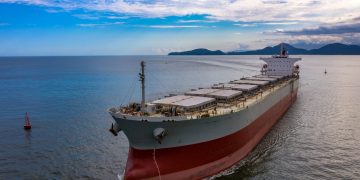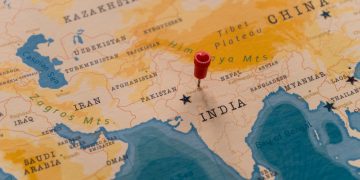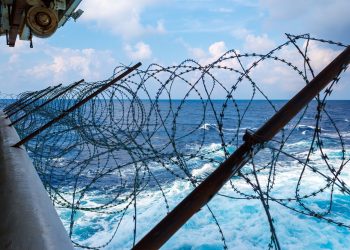Returning home after 4 months in captivity
The alarm sounded at 6:40 a.m. It could have been a fire or a man overboard. But in the waters off the coast of Oman near the Gulf of Aden, the sound meant one thing to the crew of the Enrica Ievoli: pirates.
The ship was carrying 15,000 tons of caustic soda from Iran to Turkey when it was hijacked by Somali pirates, who held the 18-man crew hostage for four long months.
The seven Indian crew members on board the Italian ship landed in Mumbai on Tuesday.
This account of their capture and release is based on interviews with five crew members and two shipping company officials.
Roopendran Parrakat, 51, had been watching the unidentified boat since he came on duty shortly before 6 a.m. on Dec. 27. He and two other crew members took turns peering through binoculars at the vessel, which showed up on the Enrica Ievoli’s radar as an ominous blip moving far too fast toward their ship.
“Normally, you get GPS data,” Parrakat said. “This vessel had no details, no name, nothing.”
Forty minutes later the captain sounded the alarm, jolting Shantilal Harji Solanki awake.
“I had a feeling pirates were around,” said Solanki, 52, who worked as a mechanic on the ship.
He stashed his gold prayer beads in an air conditioning duct before heading up to the ship’s bridge, the designated meeting point in case of emergency.
The captain told the assembled crew that pirates were approaching.
The next hour unfolded in slow motion. A skiff set out from the pirate’s mother ship.
The crew watched from the bridge as four men in shorts and T-shirts hoisted a ladder and climbed on board. Two carried AK-47s. They fired shots in the air and called themselves pirates. They said they were from Somalia.
The pirates came up to the bridge and trained their guns on the captain. “They said this boat is hijacked,” recalled Solanki. One of the gunmen was shaking. Another man was bleeding, cut on the hand and shoulder by the barbed wire the crew had wrapped around the ship to stave off pirates before entering the dangerous waters. Five more Somalis soon climbed on board. The youngest was 14, the oldest in his fifties.
The leader carried a pistol. He was perhaps 55, thin, with a gentle way of talking. He didn’t seem dangerous. The men called him Maya.
Maya told the crew he didn’t want to harm them, that there would be no killing if they got money.
“The leader told us we are hijacking this vessel for money,” said Parrakat. “We need this money for our country. We are doing this for our country.”
Maybe if they’d cut the power, darkened the boat and locked themselves in some hidden room they could have escaped, one member of the crew said. If they’d only had an armed guard on board, none of this would have happened, others said.
A helicopter flown in by the Turkish navy in response to the captain’s distress call arrived 20 minutes too late.
The pirates held the crew in the ship’s bridge, a vast room encased in glass at the top of the ship which offered 360 degree views of the surrounding ocean. Half the men got mattresses, the rest slept on blankets. They had to ask permission to go to the bathroom or take a shower. Pirates always escorted them, one man at a time. Photographs were forbidden.
The pirates led the crew – seven Indians, six Italians and five Ukrainians – one by one to their cabins and took anything that could be sold.
They stole Solanki’s two laptop computers, one of which he’d just bought for his daughter, two cellphones, his watch, his leather shoes and all his money.
After a few days, the ship reached Somali waters and the men were allowed to call home.
Solanki called his wife in Diu, an island north of Mumbai, India’s financial capital. “I told my wife, ‘I am hijacked. Don’t worry, we are OK,'” he recalled.
His two daughters were sobbing too hard to speak clearly. “Papa come soon,” they said.
The crew did not become friends with their captors over the long months of captivity. They barely learned each other’s names. The pirates slept separately and ate their own meals. The Somalis brought sheep on board, slaughtering one each day for food.
The ship sat in Somali waters day after day. The crew played cards, mostly gin rummy, to fill the empty hours. Some prayed.
Solanki, a Hindu, kept Hanuman, the monkey god, and Vishnu, the god of gods, in his mind. “You help us,” he pleaded.
Far away, the crew’s fate was being hammered out in intense negotiations between the governments of Italy and Somalia and the owners of the Marnavi shipping company.
No one thought of escape.
“Everyone was afraid for his life,” said Parrakat.
“I can’t be faster than a bullet,” said Solanki.
The Somalis were well organized, operating in concert with other pirates in the region.
Once the Enrica Ievoli reached Somali waters, Maya’s group handed the vessel over to anther crew of pirates led by a man named Loyan. The pirates communicated with each other by cellphone, or when they fell out of the network, through the ship’s satellite phone.
Twice the Enrica Ievoli was pressed into pirate service.
In January, the ship sailed two and a half days to rescue nine pirates from a failed hijacking. Five of the nine were injured and one had been shot dead by the U.S. Navy, said Solanki. The pirates put the dead body in the freezer and sailed back to Somalia.
In March, Loyan ordered the ship to chase a hijacked Spanish vessel whose captain was not following pirate orders. They never found the ship.
On April 22, more than 30 pirates, all armed, were aboard the Enrica Ievoli. They wrapped their faces in kerchiefs and cloths, hiding everything but their eyes. They lined the crew up on the deck so they could be seen, alive, from a small white plane that approached around 2:30 p.m.
The pirates kept their guns pointed at the backs of the crew as the plane circled above and then dropped three plastic containers, each fitted with a small parachute, into the sea.
The pirates scurried off the boat to collect their treasure.
A new kind of fear settled on the crew.
No one knew how much money was in those containers, but it was clear that the pirates had gotten what they asked for.
“Until that day, they had reason to keep us alive,” Parrakat said. “After they got what they wanted, they can do anything.” He stayed awake the whole night, listening as the pirates left the ship in small groups.
Around 5 a.m., the last few pirates fired three farewell shots in the air.
“It was like coming out of jail,” Parrakat said, a big smile spreading on his face.
The captain called an Italian navy ship patrolling nearby. A helicopter circled as six Italian commandoes boarded the Enrica Ievoli and scoured the ship for any trace of pirates.
“When the Italian commandoes came, we felt OK, fine, we are going home,” Solanki said. He took his prayer beads out of the air conditioning duct.
The plane that brought Solanki and six other Indian crew home touched down in Mumbai as the sun rose Tuesday. The men were greeted with garlands of flowers.
Solanki called his wife.
“I told her, I’m back in India. She said, ‘OK, OK,'” he said.
Solanki bowed his head with great dignity, trying to hide his tears. He plans to have some jewelry made for her before he flies home, he said.
Source: AP

































































